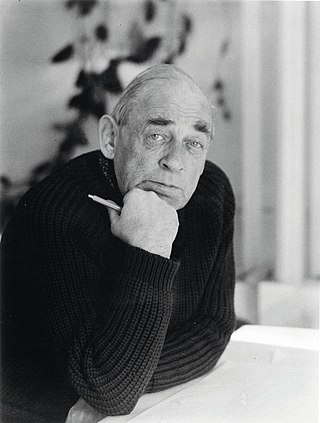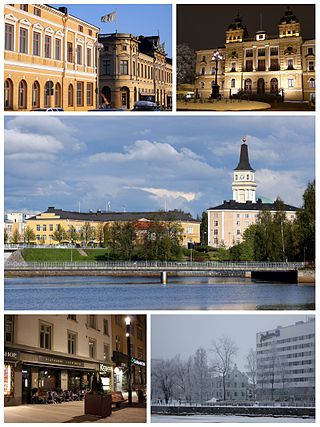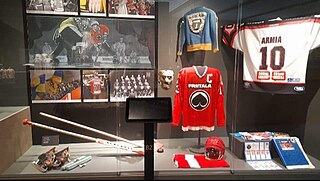
Eeli Alvar Aalto (born 6 February 1931 in Vyborg, Finland (present-day Russia)) is a Finnish visual artist and television director.

Eeli Alvar Aalto (born 6 February 1931 in Vyborg, Finland (present-day Russia)) is a Finnish visual artist and television director.
During the Winter War, Eeli Aalto and his parents fled the war to the Pohjois-Pohjanmaa region, first to Liminka and then to Oulu. [1] Eeli Aalto became acquainted with art at the age of 10 when he saw paintings by the Liminka-based artist Vilho Lampi. [1]
Aalto studied art at the Academy of Fine Arts in Helsinki and later in Paris, France at the André Lhote academy. [1]
Aalto participated in the frescoes by Lennart Segerstråle at the Rovaniemi Church. [2] He painted landscapes and city scenarios. In the 1960s Aalto also experimented in abstract art. [1] He designed a large three-part relief ("In the beginning there was the word. The word became flesh ... and lived among us", 1969) between the main entrances at the concrete facade of the Alava Church in Kuopio. In Oulu he participated in getting cultural facilities such as the Oulu University and the Oulu Museum of Art into the city. From 1962 to 1979 Aalto served as teacher of plastic composition at the department of architecture at the Oulu University.
From 1993 to 1998 Aalto painted the series "Sata kuvaa Oulusta" ("One hundred pictures of Oulu"). Eeli Aalto wrote of its birth: "We got refuge in Oulu. Why shouldn't I picture the city that accepted us?" The idea was for every picture to have its own personal meaning. [3] : 79–80 Eeli Aalto used his realistic pictures to show that figurative art had never disappeared anywhere. According to Giorgio Morandi "nothing is as abstract as reality". [3] : 86

In addition to paintings and sculptures, Aalto made numerous television documents for Yleisradio, such as a document about star singers called Synti suuri surkia in 1980. The document Piina about the artist Alpo Jaakola (1977) was awarded the Jussi Award for best television film. [4]
After the dissolution of the Soviet Union Eeli Aalto travelled to his home city of Vyborg in 1991. He said that seeing the city after half a century first felt like descending to a nightmare. "I felt a foreigner, but so did the Russian inhabitants." [5] Eeli Aalto made a documentary film Wiipurini (1992) based on his trip to Vyborg. [3] : 77
Eeli Aalto also made a series of writings and photographs called Viipurinmatka based on his trip, which he also published online in his series "100 kuvaa Oulusta". [6]
Jukka Lindfors describes Eeli Aalto's films as personal statements, a kind of television essays or pontifications. "They are often poetic and nostalgic, but they also have quite a lot of fresh humour, acridity and black satire."
According to Lindfors Eeli Aalto's artist documents give away an air of understanding reaching beyond the surface, and each subject is also reflected in the filming and editing of the films. His subjects have often been peculiar marginal characters, creative outsiders. Aalto often also appears in his films himself, sometimes as a fictive character. [7]
Aalto has written two books about artists, of which one is about Vilho Lampi (1969) and the other about Reidar Särestöniemi (1976).
From 1983 to 1988 Eeli Aalto wrote columns in the newspaper Kaleva under the title "Pienet filosofiat". Aalto wrote about four hundred columns and also illustrated them. [3] : 69
Aalto's autobiography Kuviensa takana was published in 2016. It was also published in English (2018) and in Russian accompanied with an article by Anastasia Martynova who had studied Eeli Aalto's works in 2019.
Eeli Aalto was also witness to the Jumalan teatteri act in Oulu in 1987, where the actors threw urine and excrement on the audience. [8] Aalto was the only member of the audience who watched the act in its entirety and took photographs, which were later used as evidence in a trial against the actors. In February 2009 Aalto published photographs of the act on the Internet, which had never been shown before. [8] [9]
Aalto lives in Kempele. [10] Aalto's son Simo Aalto is known as a magician, [11] Aalto's grandchildren Saara and Suvi Aalto are singers and Sari Aalto is a ventriloquist. [12]
Eeli Aalto was awarded an artist's pension in 1994. [13]
In 2012 Aalto was awarded the Kultainen kaulin ("Golden rolling pin") award for a culturally significant Oulu citizen. [14]

Hugo Alvar Henrik Aalto was a Finnish architect and designer. His work includes architecture, furniture, textiles and glassware, as well as sculptures and paintings. He never regarded himself as an artist, seeing painting and sculpture as "branches of the tree whose trunk is architecture." Aalto's early career ran in parallel with the rapid economic growth and industrialization of Finland during the first half of the 20th century. Many of his clients were industrialists, among them the Ahlström-Gullichsen family, who became his patrons. The span of his career, from the 1920s to the 1970s, is reflected in the styles of his work, ranging from Nordic Classicism of the early work, to a rational International Style Modernism during the 1930s to a more organic modernist style from the 1940s onwards.

Oulu is a city in Finland and the regional capital of North Ostrobothnia. It is located on the northwestern coast of the country at the mouth of the River Oulu. The population of Oulu is approximately 216,000, while the sub-region has a population of approximately 264,000. It is the 5th most populous municipality in Finland, and the fourth most populous urban area in the country. Oulu is also the most populous city in Northern Finland.

HIM was a Finnish gothic rock band from Helsinki. First formed in 1991 by vocalist Ville Valo and bassist Mikko "Mige" Paananen under the name His Infernal Majesty, the band broke up after only a few years, only to be reformed in 1995 by Valo and guitarist Mikko "Linde" Lindström. After being rejoined by Mige, as well as keyboardist Antto Melasniemi and drummer Juhana "Pätkä" Rantala, the band, now called HIM, released its debut album Greatest Lovesongs Vol. 666 in 1997. In 2000, now with drummer Mika "Gas Lipstick" Karppinen and keyboardist Juska Salminen, the band released Razorblade Romance, which reached the number one spot in Finland, Austria and Germany. The first single "Join Me in Death" also charted at number one in Finland and Germany, eventually going platinum and gold, respectively. Following the addition of Janne "Burton" Puurtinen on keyboards, HIM released Deep Shadows and Brilliant Highlights (2001) and Love Metal (2003). Both cracked the top ten in several countries and allowed the band to tour in the United Kingdom and the United States for the first time.

Porin Ässät, officially named Hockey Club Ässät Pori and colloquially known as Pata, is a professional ice hockey club based in Pori, Finland. It competes in the SM-liiga, the highest-ranking league of ice hockey in Finland. Since 1971, Ässät has played its games in the Isomäki Ice Hall.

Vilho Henrik Lampi was a Finnish painter who is best known for his self-portraits and paintings of Liminka and the people who lived there.
Irreligion in Finland: according to Statistics Finland in 2020, 29.4% of the population in Finland were non-religious, or about 1,628,000 people. The Union of Freethinkers of Finland and other organisations have acted as interest organisations, legal protection organisations and cultural organisations for non-religious people. In a 2018 international ISSP survey, 40% of the Finnish population said they did not believe in God, 34% said they believed in God and 26% did not know. Nearly one out of every five people in the country is not a member of a religious organisation, and the number of people with no religious affiliation has doubled in two decades.
Märta Blomstedt (1899–1982) was an architect and one of the driving forces of the Finnish functionalism movement. Partnering with her husband, Pauli E. Blomstedt, her first works were noted for their functional, rather than decorative appearance and settings in park-like environments. After her husband's death, initially she formed a firm with Matti Lampén to complete projects her husband and she had begun. Later, she and Lampén formed a firm designing their own creations. She designed all aspects of her buildings including the furnishings, demonstrated in one of Blomstedt & Lampén's most noted designs of the Hotel Aulanko. During the war, Blomstedt & Lampén mostly worked on renovation and restoration projects of existing buildings, but at the war's end, they returned to their own designs. In addition to buildings, they were responsible for the city plans for Kuusjärvi and the Oravikoski Mining Community and created both public and private buildings in each city as well. When Lampén died, Blomstedt formed a partnership with Olli Penttilä and continued to work into the 1970s.

Fingersoft is a Finnish video game developer based in Oulu. Fingersoft is one of the most northern game studios in the world, located just 170km south of the Arctic Circle. It is best known for the mobile games Hill Climb Racing and Hill Climb Racing 2, which together have over 2 billion installations.

The history of the Porin Ässät starts in 1925, when Porin Palloilijat was established, even though PoPa is often considered as a separate club from Ässät.
Jumalan teatteri was a Finnish avant-garde, radicalist group of student actors from the Helsinki Theatre Academy. The group was composed of Esa Kirkkopelto and Jari Halonen, now directors, and Jorma Tommila and Jari Hietanen, now actors. Jumalan teatteri is best remembered for their experimental act at the Oulu City Theatre in 1987, where the group used fire extinguishers, raw eggs, whips, excrement, and fireworks to drive out all but one member of the audience. Police arrested the performers, and it became an internationally known scandal.
Jouni Lanamäki is a Finnish restaurant entrepreneur who owns popular karaoke bars Oulu and In Helsinki. He has been involved in the municipal politics of Oulu in the 1990s, when he received publicity for his anti-foreigner rhetoric.
The 2016 Helsinki Asema-aukio assault happened on 10 September 2016, when Jesse Tornianen, a member of the Finnish Resistance Movement, a Neo-Nazi organisation, attacked a passer-by who had argued with the demonstrators and spit on them with a jumping kick. Because of the kick, the 28-year-old Jimi Joonas Karttunen fell down, hit his head to the street and suffered a cerebral haemorrhage. Karttunen was rushed to the Töölö Hospital, which he later left despite the hospital staff's recommendation to stay at the hospital. He died about a week after the assault on 16 September 2016 at the Meilahti Hospital. The perpetrator had a criminal background.